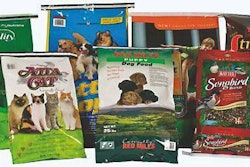North America and the US may still be king of the petfood world, but new challengers to the throne are on the rise. By 2013, Euromonitor International projects, Brazil will have vaulted to become the second largest petfood market over Japan, with Russia climbing to No. 6 while also showing the strongest compound annual growth rate (CAGR) between now and then. Petfood sales in countries such as Thailand, Romania and India will also grow rapidly through 2013.
According to Euromonitor, North America and Latin America saw the largest petfood sales increase from 2003 to 2008, followed by Western Europe (Figure 1). Eastern Europe's growth was just behind that of its western counterpart, and from now through 2013, Euromonitor projects Eastern Europe will overtake Western Europe in growth and come close to Latin America and North America. Asia Pacific will start catching up to Western Europe, too.
Looking at individual countries, you can see the players pushing these developing regions onto the world petfood stage.
Growth is the key
Euromonitor projects that by 2013, the US will still top the petfood ranks by a large margin, US$18.8 billion in sales vs. US$4.7 billion for the No. 2 country, Brazil (Figure 2). Yet Brazil will grow at 6.1% CAGR, compared with only 2.7% for the US. At No. 6, Russia will reach US$2.6 billion in sales and grow at a torrid 13.3% CAGR. Mexico is another developing market that will figure in the Top 10 in petfood by 2013, at US$1.5 billion in sales and 2.1% CAGR.
Among the top markets from more developed regions, only Italy will still be growing at close to 5% CAGR. Most of the other developed countries among the 10 largest petfood markets will see growth in only the 1-2% range, with Germany experiencing a negative CAGR (-0.8%). This is because German consumers continue to to be price-sensitive and prefer to buy private label petfoods or from discounters, Euromonitor says.
When you look at the Top 10 markets by growth through 2013, all are from the developing world (Figure 3). This includes five countries from Asia, plus four from Eastern Europe and one from Latin America (Argentina). After Russia, Thailand checks in with the second strongest CAGR (11.8%), followed closely by Romania at 11.6% and India at 11.4%.
More mouths to feed
The reasons for the strong growth vary from country to country but Euromonitor identifies two common trends:
- Changing demographics in emerging markets, including increasing pet ownership;
- Large gaps between the number of cats and dogs owned and the amount of prepared petfoods fed.
By 2015, half the world's population will live in urban environments, Euromonitor says, with countries like China and India experiencing the greatest urban growth as people are drawn to the increasing concentration of global economic activity in cities.
This leads to rising disposable incomes, creating more favorable conditions for modern retail trade (even with the current recession causing a slowdown). Increasing urbanization and disposable incomes also mean higher levels of pet ownership in emerging markets, which have already seen huge growth rates over the past 10 years. From 1998 to 2008 the number of cats and dogs owned in Brazil and Turkey rose 49%, reaching a total of nearly 50 million pets in Brazil.
China's total of pet dogs and cats now stands at almost 38 million after 38% growth over the last 10 years. India saw 45% growth and now has 7.6 million cats and dogs.
Scrapping table scraps
Not only are there all those canine and feline mouths now to feed in these developing countries but the relatively low level of pet owners feeding commercially prepared foods means a huge potential market for the petfood industry. Among the Top 10 fastest growing petfood markets, only Argentina has total consumption of prepared petfoods above 25%, which still lags far below the levels in developed markets, according to Euromonitor.
In many of these fast-growing markets-Romania, India, Indonesia, China and Ukraine-the total consumption of prepared petfoods barely reaches 5-10%. This creates plenty of opportunities for petfood companies to encourage pet owners to switch from table scraps and home-cooked foods to more convenient prepared petfood.
Countries like Brazil and Russia, already on their way to joining the Top 10 largest petfood markets, demonstrate how filling the gap between pets owned and prepared petfoods fed leads to growing sales. In Brazil, consumption of prepared petfoods surpassed 40% in 2008, Euromonitor says, an increase of nearly 20 percentage points from 1998. Accordingly, the three fastest-growing petfood companies from 2006 to 2007 were all from Brazil: Nutriara Alimentos Ltda, Total Alimentos SA, Mogiana Alimentos SA. Nutriara and Total are among the Top 10 largest petfood companies worldwide.
As Euromonitor points out, with more first-time petfood buyers in emerging markets trading up from table scraps to economy and mid-price products, these owners may become the premium petfood customers of tomorrow.



(1).png?auto=format%2Ccompress&fit=crop&h=167&q=70&w=250)
(1).png?auto=format%2Ccompress&fit=crop&h=167&q=70&w=250)











